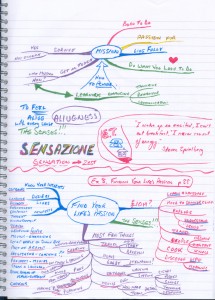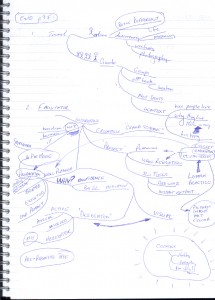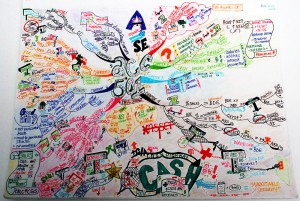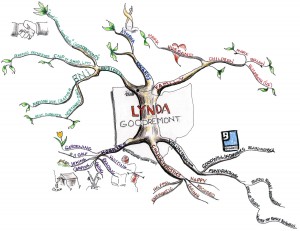An Idea Mapping Success Blogs Weblog
Hint #7 & Idea Map #12 – A Picture is Worth a Thousand Words
26 Apr 2007 Author: Jamie Nast In: Helpful Hints, Idea Mapping Example, Mind Mapping ExamplesClick here for the pdf version that is larger and easier to read the details.
Hint #6: A Plethora of Markers
23 Apr 2007 Author: Jamie Nast In: Helpful HintsI have an addiction to colored markers. At some point in time, I think I’ve used nearly every marker created. If you’ve found yourself buying markers, and then not being particularly happy — this posting is for you. Listed below are some of the brands I enjoy. I’ll explain some of their differences as we go through the list.
- Staedtler – These are my favorite markers (I think)! They come in both fine and medium tips. Best of all is the sturdy case that stands at an angle for easy use while mapping.
- Stabilo – Also a high quality marker.
- Sharpies – Vibrant colors. The only caution here is that they bleed through regular copy paper.
- Fiddle Sticks – This 10-pack is a medium point and brilliant colors. Best part about these is that each marker has its own scent.
- Pentel – Also a medium point with a wide color selection. The vinyl case is OK. Mine finally fell apart after many years of use.
- TOMBOW Dual Brush-Pen – These markers are pretty clever. One end is a medium point, the other end is a wide brush stroke. There is a wide selection of colors and a flimsy plastic case that works well.
- Mr. Sketch (12-pack) – These are thick, scented markers with nice color. I use these when teaching (flip charts) or creating large idea maps.
- Crayola – These start out as fine points, but typically become medium point. I don’t find the colors as brilliant as the Fiddle Sticks, but you can find them anywhere. Around August you can often find them for $1.00 or less during the “back-to-school” specials.
The worst markers in all of my experience are the packages of 20 or 30 that you can get at the dollar store. If they don’t bleed all over, they will be dried up in about a day. Colors are not vibrant — basically a waste. Let me know if you have other markers that you would recommend.
Idea Map #11 – Considered Colour by Steve
19 Apr 2007 Author: Jamie Nast In: Helpful Hints, Idea Mapping Example, Memory, Mind Mapping ExamplesThe purpose of this map was to remember some key concepts and how my interests and experiences relate to them. Although a number of rules are broken here also, it’s fairly neat and I have taken time to use colour and images. I wanted to make the map memorable.
Idea Map #10 – Fast ‘n Furious from Steve
19 Apr 2007 Author: Jamie Nast In: Helpful Hints, Idea Mapping Example, Mind Mapping ExamplesI drew these in less than 2 minutes (and it shows) however these simple scribbles have driven major developments in my career.”
National Graduate School (NGS) Uses MindManager and the Idea Mapping Book as Part of Their Curriculum
18 Apr 2007 Author: Jamie Nast In: idea mapping bookThe National Graduate School (NGS) is an accredited institution offering a Masters Degree and Professional Certificates. They’ve just launched new classes this spring for approximately 100 students. All students purchase the MindManager software through the reseller, CampusTech. In their first course, all students start the MindManager program coupled with the Idea Mapping book.
Students are from:
1. US Coast Guard
2. US Army
3. US Navy
4. United Technologies (Pratt & Whitney, Hamilton Sunstrand)
What a powerful way to help students succeed and learn right from the beginning of their studies.
My husband and I were invited to a luncheon today at the University of Detroit Mercy (UDM). It was called “Celebration of Education” and was sponsored by the Willow Run/Ypsilanti, Michigan Dollars for Scholars (DFS) organization.
My role began with DFS during the 2001-2002 school year and went four consecutive years. During that first school year, I taught idea mapping and other tools to 55 Willow Run High School students and 10 of their teachers. The students were incredible and I can still picture many of them — Alana, Erica, Precious, Christian, and many more. I haven’t seen any of them since they graduated…until today.
Among the presitigious series of speakers at today’s luncheon (which easily hosted over 200 guests) was a Willow Run alumni named Mishae Johnson. She had been part of that original group of 55 students, had since earned her bachelor’s degree from UDM, and was squeezing us into her busy schedule on her lunch break from work. She was an amazing speaker, sincere, connected with the audienc, articulate, and never used a single note.
Afterwards we had a chance to talk and catch up a bit. She shared that she used idea mapping tool all the way through college. She specifically shared how it had helped her in a math class.
It’s not often that instructors get to see the fruit of their work once the student or participant leaves the workshop. Today I was given a gift to know that somehow this tool made a difference for one college student. Thank you Mishea Johnson.
Idea Map #9: U of M Financial Accounting Class – by Jennifer Webb from Ford Motor Company
14 Apr 2007 Author: Jamie Nast In: Idea Mapping Example, Idea Mapping Workshops, Mind Mapping Examples, Studying for ExamsI’m SO excited to share this idea map and story with you. The posting on December 16, 2006 briefly mentioned Jennifer’s map, but now you can see both the map and read the complete story in her own words. Two of Jennifer’s pre-workshop maps are also viewable on my website if you want to see the before and after comparison. It’s quite amazing. Here’s Jennifer:
One of my first graduate business classes at U of M was Financial Accounting. I struggled to grasp the intricacies of financial accounting throughout the semester. I did fairly well on the first exam, but failed the second exam. At that point I was extremely disheartened and actually considered dropping out of the MBA program! I put in so many hours of studying for the class, but I didn’t see the results. I just didn’t know how else to study more effectively and was at a loss for solutions.
Shortly after the second exam, I took Jamie Nast’s Idea Mapping class at my workplace. I wasn’t sure if I should apply this new skill to an old problem. Knowing how much time it would take me to completely review the entire book and create an Idea Map was daunting, but I decided to go for it.
The process of creating the Idea Map was an excellent review of the semester’s material in and of itself. It allowed me to see connections between topics and ‘how’ and ‘why’ things were interrelated. I reviewed this map for several days before the final exam and used this map as my in-class note sheet for the final exam.
I’m extremely happy to report that I passed the class with a B+; a huge improvement from my grade at midterm! I found Idea Maps to be an excellent way for me to effectively study for my exam and to truly grasp the interconnectedness of the material.
Jennifer Webb
Hint #5 – If Your Idea Map Gets Messy, Should You Re-draw It?
13 Apr 2007 Author: Jamie Nast In: Helpful HintsWhat do you do when your map gets a bit sloppy? The purpose of your idea map or mind map may fall into one of several categories, so let me provide some suggestions for some scenarios.
- This idea map is for my “to do” list. For some reason there can be a tendancy for people (myself included) to want these maps to look like pieces of artwork instead of seeing them as functional tools created to meet a purpose. I had to allow myself to cross off completed items and squeeze new items onto the maps until the map was such a mess I needed to start fresh. Recreating the map each time it got a tiny bit messy, became a waste of time. These types of maps should not be re-drawn until absolutely necessary.
- This idea map is for an application that has a sequence to it (a process, a schedule, or a presentation for example). During the creation of a map the ideas are generated randomly, so it is unlikely that your map will be perfectly sequential on the first draft. The initial map provides the opportunity for you to step back and see the data from the big picture view. This enables you to re-sequence (maybe by numbering the branches), discover relationships between data points, and in some cases re-organize. If you are creating a linear document from this map, there is no need to re-draw. If you are using this map in the future or presenting from it, I would re-draw a final version.
- This idea map contains a large amount of information. If you find the re-drawing process cumbersome or annoying, maybe you should use software to make the editing process extremely easy.
I guess the bottom line is to determine the purpose of your map before re-drawing it multiple times. Don’t re-draw the map just for the sake of re-drawing. Sloppy idea maps can be just as useful as the most beautifully drawn example!
WANTED: Software-Produced Maps
11 Apr 2007 Author: Jamie Nast In: Mind Mapping SoftwareChuck Frey has become one of this industry’s best collectors and analyzers of software-produced maps. Following is his request. As you send your examples to Chuck, please copy me as well and you will be published in both venues.
According to my surveys of mind mapping software users, one of the biggest needs that many of you have is to see examples of successful software-produced mind maps, and to understand what makes them work. Many of you are looking for case histories that illustrate some of the best practices of visual mapping. As part of my research for an expanded and updated second edition of my “Power Tips & Strategies for Mind Mapping Software” e-book, I have decided to address this need. If you have used mind mapping software to create a visual map that meets your needs exceptionally well, I’d like to hear from you. Please submit a case history and send me a screen shot of your favorite productivity-increasing map.
I have created a simple Word document where you can submit your information. To download this form, please click on link below, and save it to your computer. The document contains instructions to help you write your case history. If I use your case history in my e-book, you will receive a free copy of it when it is published. http://mindmapping.typepad.com/Case_History_Form.doc
- 0 Comments
- Tags: Chuck Frey, mapping software
Idea Map #8 – Celebration of Life
8 Apr 2007 Author: Jamie Nast In: Certified Idea Mapping Instructors, Idea Mapping Example, Liza Seiner, Mind Mapping ExamplesEaster Sunday could not be a more appropriate day to show viewers this map. I’ve called this idea map “A Celebration of Life”. I got a call from John Meyer asking if I could create a map for a friend of his. Yes, I could….but I knew someone who could do even better!
This map was created by Liza Jennings Seiner in response to a request from John Meyer, a dear friend and colleague of Lynda Goodremont who is fighting cancer. He had this map created as a gift for her in celebration of her life. Liza is also a Certified Idea Mapping Instructor.
Idea Mapping Blog
The purpose of this blog is to share idea mapping examples and related learning from my Idea Mapping, Memory, Speed Reading, and Certification Workshops. This blog is dedicated to my Certified Idea Mapping Instructors, my clients, Mind Mapping and Idea Mapping practitioners around the globe.

![[Ask]](http://ideamapping.ideamappingsuccess.com/IdeaMappingBlogs/wp-content/plugins/bookmarkify/ask.png)
![[del.icio.us]](http://ideamapping.ideamappingsuccess.com/IdeaMappingBlogs/wp-content/plugins/bookmarkify/delicious.png)
![[Digg]](http://ideamapping.ideamappingsuccess.com/IdeaMappingBlogs/wp-content/plugins/bookmarkify/digg.png)
![[Facebook]](http://ideamapping.ideamappingsuccess.com/IdeaMappingBlogs/wp-content/plugins/bookmarkify/facebook.png)
![[Google]](http://ideamapping.ideamappingsuccess.com/IdeaMappingBlogs/wp-content/plugins/bookmarkify/google.png)
![[MySpace]](http://ideamapping.ideamappingsuccess.com/IdeaMappingBlogs/wp-content/plugins/bookmarkify/myspace.png)
![[Slashdot]](http://ideamapping.ideamappingsuccess.com/IdeaMappingBlogs/wp-content/plugins/bookmarkify/slashdot.png)
![[Sphinn]](http://ideamapping.ideamappingsuccess.com/IdeaMappingBlogs/wp-content/plugins/bookmarkify/sphinn.png)
![[StumbleUpon]](http://ideamapping.ideamappingsuccess.com/IdeaMappingBlogs/wp-content/plugins/bookmarkify/stumbleupon.png)
![[Technorati]](http://ideamapping.ideamappingsuccess.com/IdeaMappingBlogs/wp-content/plugins/bookmarkify/technorati.png)
![[ThisNext]](http://ideamapping.ideamappingsuccess.com/IdeaMappingBlogs/wp-content/plugins/bookmarkify/thisnext.png)
![[Twitter]](http://ideamapping.ideamappingsuccess.com/IdeaMappingBlogs/wp-content/plugins/bookmarkify/twitter.png)
![[Webride]](http://ideamapping.ideamappingsuccess.com/IdeaMappingBlogs/wp-content/plugins/bookmarkify/webride.png)
![[Email]](http://ideamapping.ideamappingsuccess.com/IdeaMappingBlogs/wp-content/plugins/bookmarkify/email.png)



